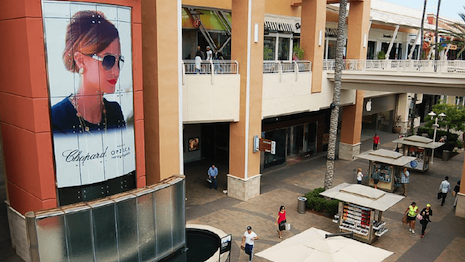- About
- Subscribe Now
- New York,
August 21, 2019

 Bricks-and-mortar retail must continue to adapt. Image credit: Simon
Bricks-and-mortar retail must continue to adapt. Image credit: Simon
Retailers need to ensure technology enhances the shopping experience without distracting from human interactions, as today’s consumers still desire quality service over innovative technology.
Although preferences vary by generation, the majority of shoppers are seeking service, value and efficiency when it comes to physical retailers, according to a new report from JLL. To motivate more consumers to shop offline rather than online, shopping centers also need to diversify their offerings beyond retail.
“Luxury retailers should focus on the idea of prioritizing people, part of which is personalization,” said Taylor Coyne, retail research manager at JLL, Los Angeles. “Often with luxury goods, shoppers spend time researching and understanding a product before spending what can often be a significant amount of money.
“By prioritizing customer service and ensuring a thoughtful customer service person is available to teach customers about the brands’ products, luxury retailers can more efficiently facilitate the path to purchase,” she said.
JLL’s “Future of Retail” report is based on a survey of more than 1,500 adult consumers in the United States, from baby boomers to Generation Z. JLL defines millennials as between ages 25 and 34 and Generation Z consumers as between 18 and 24.
Convenient consumption
More than 90 percent of retail sales still take place in bricks-and-mortar stores, as shoppers look to interact with helpful sales associates. Personalized service was a deciding factor in where to shop for more than half of respondents.
Although younger consumers are channel agonistic, about 71 percent of millennial and Generation Z shoppers believe it is important that a store remembers their preferences. By contrast, only 62 percent of seniors felt remembering personal preferences was important for stores.
“Personalization is just one aspect of the retail experience and it really speaks to how we choose the brands and how we as shoppers become brand loyal,” Ms. Coyne said. “With so many different options out there, customers want some kind of return for their loyalty, and often that is through personalization.”
Most consumers look at customer service to differentiate shopping experiences. Image credit: Neiman Marcus
Half of consumers believe a skilled customer service person can improve their shopping experiences, while less than 20 percent felt their smartphones can make shopping better.
Less than 8 percent want artificial intelligence robots that assist customers while shopping. Furthermore, only 11.3 percent of shoppers expect to see customer service robots in the next 10 years.
Nearly a third, 31.5 percent, do expect seamless checkouts to be perfect in the next decade, if not earlier.
Same-day delivery is also becoming an expectation among more than 36 percent of shoppers, especially as click-and-collect services become more mainstream.
For instance, department store brand Nordstrom’s The Local concept offers services such as on-site tailoring, curbside pickup, click-and-collect and returns in a convenient location (see story).
Shoppers are also most twice as receptive to interactive technology at electronics stores, at 30.8 percent, compared to 16.7 and 14.5 percent of consumers who want more technology at apparel retailers or department stores.
Nearly four in 10 shoppers expect to see more innovative retailers in shopping centers in the next decade, while a third want more entertainment and dining options. About 16 percent want shopping centers to incorporate non-retail uses.
About 30 percent of all consumers are looking for family-friendly entertainment, including 40.3 percent of xennials, those consumers between ages 35 and 44. Gen Z consumers in particular are drawn to activities such as indoor skydiving, arcades and virtual reality experiences.
Dining options keep consumers at retail centers longer. Image credit: Harvey Nichols
The most popular non-retail options at shopping centers include chef-driven food halls, favored by 31.8 percent of millennials, and high-end dine-in movie theaters, preferred by 32.9 percent of Generation Z.
Food and beverage options will also continue to draw in shoppers.
According to JLL’s 2019 Foodservice Trend report, 40 percent of consumers select their favorite retail destinations based on available dining options. Shoppers who enjoy foodservice at retail centers spend an average 15 percent more on purchases (see story).
Thoughtful retail
Wellness and sustainability are also impacting retail, especially as more eco-conscious consumers gain purchasing power.
More than 41 percent of all shoppers want open lawns or greenery incorporated into shopping centers, while 37.6 percent want stores with healthy food options. More fitness center and gyms are also leasing spaces at retail destinations.
There is even potential for more tenants from the healthcare space. About 20 percent of respondents would like to see urgent care clinics in shopping centers, including 26.9 percent of boomers and 24.4 percent of Gen Z consumers.
Sustainability continues to shape retail as well.
More than 70 percent of millennial and Gen Z consumers are open to renting trendy, well-crafted goods. About 13 percent of all consumers are willing to rent clothing or home furnishings.
Department store chain Bloomingdale’s is set to debut its own rental subscription service, becoming the first luxury retailer to enter the increasingly competitive space.
Although other high-end retailers have linked up with subscription services or partnered with secondhand resellers, this marks the first time a traditional bricks-and-mortar brand is merging the two. Interest in subscription services and secondhand apparel is on the rise, particularly among millennials who look to balance convenience with sustainability (see story).
“We expected the number [of people willing to rent and share goods] to be higher with the younger generational groups, especially the Gen Z cohort, but it was interesting to see that more than half of boomers and almost half of seniors are also willing to rent items,” JLL’s Ms. Coyne said. “This is a strong indicator that we’ll continue to see new retail concepts that focus on sharing and renting goods and new partnerships between brands that allow more traditional retailers to capitalize on this trend.”
Share your thoughts. Click here